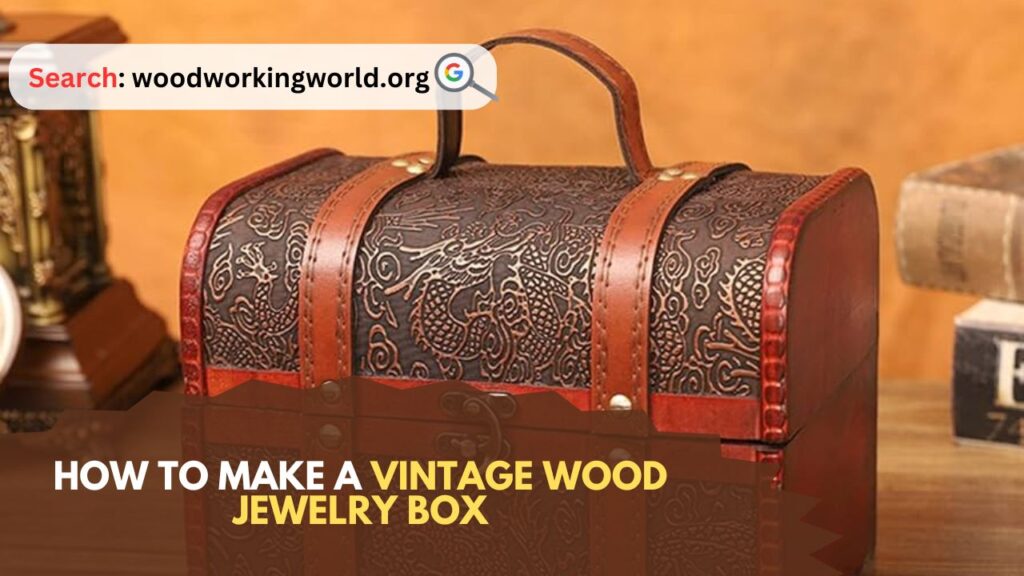Vintage Wood Jewelry Box: Creating a vintage wood jewelry box is a rewarding and fulfilling project that combines craftsmanship, creativity, and the charm of a bygone era. Whether you’re an experienced woodworker or a beginner, this guide will walk you through the steps needed to create a beautiful and functional piece that can be cherished for years. Let’s delve into the materials, tools, and techniques required to make your own vintage wood jewelry box.

How to Make a Vintage Wood Jewelry Box
Materials Needed to Make a Vintage Wood Jewelry Box
- Wood: Choose a hardwood like oak, walnut, or cherry for durability and aesthetics.
- Hinges: Vintage-style brass or antique hinges add a classic touch.
- Latches: A decorative latch that matches the hinges.
- Sandpaper: Various grits (100, 150, 220) for smoothing the wood.
- Wood Glue: For strong and secure joints.
- Stain or Paint: Depending on the desired finish.
- Varnish or Polyurethane: For a protective finish.
- Felt or Velvet: For lining the inside of the box.
- Woodworking Tools: Saw, chisel, clamps, ruler, pencil, and drill.
Step-by-Step Guide
Step 1: Designing Your Jewelry Box
Start by sketching a design for your jewelry box. Consider the size and style you want. A typical vintage jewelry box might have a main compartment, a lift-out tray, and perhaps a few small drawers. The exterior can feature carved details or inlays to enhance the vintage look.
Step 2: Selecting and Preparing the Wood
Choose high-quality hardwood for your box. Measure and mark the dimensions on the wood using a pencil and ruler. For a standard jewelry box, you’ll need pieces for the base, sides, top, and any internal dividers or trays.
- Cutting the Wood: Use a saw to cut the wood pieces to size. Ensure all pieces are cut accurately for a perfect fit.
- Sanding: Sand each piece with coarse sandpaper (100 grit), then move to finer grits (150 and 220) to achieve a smooth finish. This step is crucial for removing any splinters and preparing the wood for staining.
Step 3: Assembling the Box
- Base and Sides: Apply wood glue to the edges of the base and attach the side pieces. Use clamps to hold them in place until the glue dries. Ensure the corners are square.
- Top: Attach the top piece using hinges. Measure and mark where the hinges will go, then carefully chisel out recesses for the hinges so they sit flush with the wood. Screw the hinges into place.
- Internal Dividers and Trays: Cut and fit any internal dividers or trays according to your design. Glue and clamp them in place.
Step 4: Adding Decorative Details
- Carvings and Inlays: If you want to add carvings or inlays, sketch the design onto the wood and carefully carve it out using chisels. For inlays, cut out the shape and fit a contrasting wood piece into the recess.
- Edges and Corners: Round off edges and corners with sandpaper or a router for a smooth, finished look.
Step 5: Finishing the Wood
- Staining: Apply wood stain using a brush or cloth, following the grain of the wood. Allow the stain to penetrate for a few minutes, then wipe off the excess with a clean cloth. Repeat if necessary to achieve the desired color.
- Painting: If you prefer a painted finish, apply a wood primer first, then paint with your chosen color. Vintage boxes often look great with a distressed paint finish – sand the edges lightly after painting to give an aged appearance.
- Protective Finish: Apply a coat of varnish or polyurethane to protect the wood. Use a brush to apply thin, even coats, sanding lightly between coats for a smooth finish.
Step 6: Lining the Interior
- Measuring and Cutting: Measure the interior dimensions of the box and cut felt or velvet to fit. Make sure to include pieces for the bottom, sides, and any trays.
- Gluing: Apply a thin layer of glue to the interior surfaces and press the fabric into place, smoothing out any wrinkles or bubbles. For a more refined look, consider using adhesive spray.
Step 7: Attaching Hardware
- Hinges and Latches: Attach the hinges to the top and back of the box if you haven’t already. Attach the latch to the front, ensuring it aligns correctly for secure closure.
- Handles and Feet: If your design includes handles or feet, attach them now. Vintage-style handles can add a lot of character to the finished piece.
Step 8: Final Touches
- Polishing: Give the entire box a final polish with a soft cloth to enhance the finish.
- Inspecting: Check all joints, hinges, and latches to ensure they are secure and functioning properly. Make any necessary adjustments.
Tips for Success
- Precision: Accurate measurements and cuts are essential for a well-fitting box. Double-check dimensions before cutting.
- Patience: Allow glue and finishes to dry completely between steps to ensure the best results.
- Creativity: Don’t be afraid to add your own creative touches, whether it’s through unique carvings, special hardware, or personalized inlays.
Conclusion: How to Make a Vintage Wood Jewelry Box
Creating a vintage wood jewelry box is not only a satisfying woodworking project but also results in a beautiful and practical item that can be a cherished heirloom. By following these steps and taking your time to ensure each part of the process is done with care, you’ll have a stunning piece that reflects both your craftsmanship and personal style. Enjoy the process, and happy woodworking!
I hope this article on How to Make a Vintage Wood Jewelry Box has been helpful. If you have any further questions, please feel free to leave a comment below.
Video
